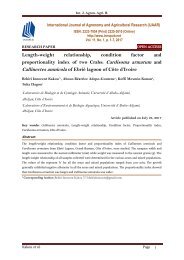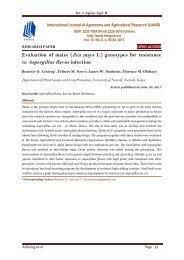Evaluation on drought and heat tolerance capacity of chickpea
Abstract Chickpea (Cicer arietinum L.) is one of the important legumes widely grown for dietary proteins in semi-arid Mediterranean climatic conditions. To evaluate the genetic diversity with improved heat and drought tolerance capacity in chickpea, thirty-four selected chickpea genotypes were tested under different field-growing conditions (rain fed winter sowing, irrigated-late sowing and rain fed-late sowing) in 2015 and 2016 growing seasons. A factorial experiment in randomized complete block design with 3 reps was conducted at the Eastern Mediterranean Research Institute Adana, Turkey. Based on grain yields under different growing conditions, the values of tolerance index, mean productivity, yield index, yield stability index, stress tolerance index, stress susceptibility index, and geometric mean productivity were calculated to identify economically higher-yielding chickpea genotypes with greater heat and drought tolerance capacity. There were highly significant differences observed among the tested chickpea genotypes response to drought and heat stresses. Besides, in both non-stress and stress conditions mean productivity, yield index, stress tolerance index, and geometric mean productivity, which highly positively significantly correlated with seed yields, were the best indices. Among the chickpea genotypes, the Aksu, Arda, Çakır, F4 09 (X 05 TH 21-16189), FLIP 03-108 were identified with a higher drought and heat tolerance capacity. Based on our field studies, it is suggested that the drought and heat tolerance indicators of plants can be used by breeders to select stress-resistant economically productive chickpea genotypes suitable to grow under Mediterranean climatic conditions.
Abstract
Chickpea (Cicer arietinum L.) is one of the important legumes widely grown for dietary proteins in semi-arid Mediterranean climatic conditions. To evaluate the genetic diversity with improved heat and drought tolerance capacity in chickpea, thirty-four selected chickpea genotypes were tested under different field-growing conditions (rain fed winter sowing, irrigated-late sowing and rain fed-late sowing) in 2015 and 2016 growing seasons. A factorial experiment in randomized complete block design with 3 reps was conducted at the Eastern
Mediterranean Research Institute Adana, Turkey. Based on grain yields under different growing conditions, the values of tolerance index, mean productivity, yield index, yield stability index, stress tolerance index, stress susceptibility index, and geometric mean productivity were calculated to identify economically higher-yielding chickpea genotypes with greater heat and drought tolerance capacity. There were highly significant differences observed among the tested chickpea genotypes response to drought and heat stresses. Besides, in both non-stress and stress conditions mean productivity, yield index, stress tolerance index, and geometric mean productivity, which highly positively significantly correlated with seed yields, were the best indices. Among the chickpea genotypes, the Aksu, Arda, Çakır, F4 09 (X 05 TH 21-16189), FLIP 03-108 were identified with a higher drought and heat tolerance capacity. Based on our field studies, it is suggested that the drought and heat tolerance indicators of plants can be used by breeders to select stress-resistant economically productive chickpea genotypes suitable to grow under Mediterranean climatic conditions.
You also want an ePaper? Increase the reach of your titles
YUMPU automatically turns print PDFs into web optimized ePapers that Google loves.
Int. J. Agr<strong>on</strong>. Agri. R.<br />
Regarding the <strong>heat</strong> stress, SSI values ranged from<br />
0.18 to 2.27 <strong>and</strong> 0.27-1.76 in 2015 <strong>and</strong> 2016. In 2015<br />
Hasanbey cultivars had the least SSI value <strong>and</strong><br />
followed by FLIP 03-126 C, FLIP 05-170 C, ILC 8617,<br />
ENA 8-2, FLIP 03-108 C, Azkan, EN 952, FLIP 03-21<br />
C, FLIP 05-150 C <strong>and</strong> ICC 1205 cultivars. In 2016,<br />
ICC 1205, Aksu, FLIP 87-59 C, Çakır, ICC 4567, EN<br />
766, ENA 8-2, Azkan, F4 09 (X 05 TH 69-16124-8),<br />
FLIP 03-21 C, FLIP 03-108 C cultivars had lower SSI<br />
value. For SSI, in both research years, ENA 8-2, FLIP<br />
03-108 C, Azkan <strong>and</strong> FLIP 03-21 C were desirable<br />
<strong>heat</strong> tolerant genotypes. Screening based <strong>on</strong> SSI will<br />
lead to reduced yield under well-c<strong>on</strong>diti<strong>on</strong>s. These<br />
results are accordance with those <strong>of</strong> Naderi <strong>and</strong><br />
Emam (2014) <strong>and</strong> Yucel <strong>and</strong> Mart (2014). However,<br />
the results <strong>of</strong> many researchers have found that SSI is<br />
not very suitable for identifying stress tolerant<br />
genotypes (Sio-Se Mardeh et al., 2006; Bazrafsham et<br />
al., 2008; Clarke et al., 1992).<br />
In <strong>drought</strong> stress, TE values ranged from 101.46 to<br />
509.95 <strong>and</strong> from 194.24 to 609.16 in 2015 <strong>and</strong> 2016,<br />
respectively. In terms <strong>of</strong> TE value, Azkan, İnci, F4 09<br />
(X 05 TH 69-16124-8), FLIP 03-28 C, FLIP 01-24 C,<br />
FLIP 03-42 C, FLIP 05-150 C, FLIP 01-39 C, Arda <strong>and</strong><br />
Seçkin cultivars had higher value in 2015. Also, the<br />
highest TE value was obtained from Azkan <strong>and</strong><br />
followed by F4 09 (X 05 TH 69-16124-8), FLIP 01-24<br />
C, EN 1750, FLIP 03-28 C, Arda, FLIP 01-54 C, EN<br />
766, FLIP 05-170 C, Aksu, Hasanbey <strong>and</strong> FLIP 03-126<br />
C in 2016. In both research years, Azkan was the most<br />
<strong>drought</strong> tolerant genotypes as to TE indices. TE<br />
values ranged from 104.76 to 230.13 <strong>and</strong> 108.69-<br />
212.36 in 2015 <strong>and</strong> 2016 in <strong>heat</strong> stress c<strong>on</strong>diti<strong>on</strong>.<br />
Dikbaş, İnci, F4 09 (X 05 TH 80-16105-31-2), FLIP<br />
03-28 C, Seçkin, FLIP 01-54 C, İzmir-92, FLIP 01-24<br />
C, EN 808 <strong>and</strong> FLIP 03-42 C cultivars had high TE<br />
value in the first year. In 2016, FLIP 01-24 C, FLIP<br />
03-28 C, EN 1750, Seçkin, FLIP 01-54 C, FLIP 01-39<br />
C, F4 09 (X 05 TH 80-16105-31-2), FLIP 03-126 C,<br />
İnci <strong>and</strong> FLIP 05-170 C had high TE value in <strong>heat</strong><br />
stress c<strong>on</strong>diti<strong>on</strong>.<br />
Averaged across Chickpea genotypes, in 2015 <strong>and</strong><br />
2016 growing seas<strong>on</strong>s, grain yields in resp<strong>on</strong>se to <strong>heat</strong><br />
stress were significantly decreased by 73 % <strong>and</strong> 69 %,<br />
respectively.<br />
The results indicated that crop yields under <strong>heat</strong><br />
stress were lower in all genotypes than under n<strong>on</strong>stressed<br />
c<strong>on</strong>diti<strong>on</strong>s in 2015 <strong>and</strong> 2016 (Fig. 3 <strong>and</strong><br />
Fig. 4).<br />
Regarding the <strong>drought</strong> stress, GMP values ranged<br />
from 36.34 to 169.93 <strong>and</strong> from 61.87 to 174.37 in 2015<br />
<strong>and</strong> 2016, respectively. In 2015, the highest value was<br />
obtained from Arda cultivar <strong>and</strong> followed by Aksu,<br />
FLIP 03-108 C, F4 09 (X 05 TH 21 16189-12-4),<br />
Çakır, FLIP 87-59 C, Hasanbey, Azkan, FLIP 03-21 C,<br />
İnci <strong>and</strong> EN 1685. In 2016, the highest value was<br />
obtained from Inci cultivar <strong>and</strong> followed by Aksu,<br />
FLIP 87-59 C, Arda, FLIP 03-108 C, Hasanbey, F4 09<br />
(X 05 TH 21 16189-12-4), FLIP 03-21 C, FLIP 05-150<br />
CFLIP 03-42 C <strong>and</strong> Çakır.<br />
According to GMP, the desirable <strong>drought</strong> genotypes<br />
were Arda, Aksu, FLIP 03-108 C, Çakır, F4 09 (X 05<br />
TH 21 16189-12-4), Hasanbey <strong>and</strong> FLIP 03-21 C. In<br />
<strong>heat</strong> stress c<strong>on</strong>diti<strong>on</strong>, GMP values ranged from 22.96<br />
to 117.87 <strong>and</strong> 29.58-117.03 in 2015 <strong>and</strong> 2016. In 2015,<br />
F4 09 (X05 TH 21 16189-12-4), FLIP 87-59 C, Aksu,<br />
Çakır, Arda, Seçkin, FLIP 03-108 C, EN 1685, FLIP<br />
03-21 C <strong>and</strong> ENA 8-2 had high GMP value. In 2016,<br />
İnci, FLIP 03-21 C, F4 09 (X05 TH 21 16189-12-4),<br />
FLIP 03-108 C, FLIP 03-42 C, FLIP 87-59 C,<br />
Hasanbey, Çakır, FLIP 05-150 C <strong>and</strong> Arda cultivars<br />
had high GMP value. According to GMP, F4 09 (X05<br />
TH 21 16189-12-4), FLIP 87-59 C, FLIP 03-21 C <strong>and</strong><br />
Arda were <strong>heat</strong> tolerant genotypes in both research<br />
years. Many studies (Ali <strong>and</strong> El-Sadek, 2016; Moein et<br />
al., 2015; Bellague et al., 2016) indicated that GMP is<br />
useful for identifying stress-tolerant genotypes that<br />
perform well in stress envir<strong>on</strong>ment Therefore, the<br />
genotypes with high GMP can be c<strong>on</strong>sidered as<br />
tolerant. Drought stress intensity was calculated as<br />
0.61 <strong>and</strong> 0.69 for 2015 <strong>and</strong> 2016 growing seas<strong>on</strong>.<br />
Besides, <strong>heat</strong> stress intensity was calculated as 0.27<br />
<strong>and</strong> 0.30 in 2015 <strong>and</strong> 2016.<br />
Correlati<strong>on</strong> co efficient between yield <strong>and</strong> <strong>drought</strong> <strong>and</strong><br />
<strong>heat</strong> stress indices in 2015 <strong>and</strong> 2016 are presented in<br />
Table 6 <strong>and</strong> 7. In <strong>drought</strong> <strong>and</strong> <strong>heat</strong> stress c<strong>on</strong>diti<strong>on</strong>s <strong>of</strong><br />
two research years, there was a significantly positive<br />
correlati<strong>on</strong> between (Yp) <strong>and</strong> (Ys).<br />
Yücel et al. Page 115





